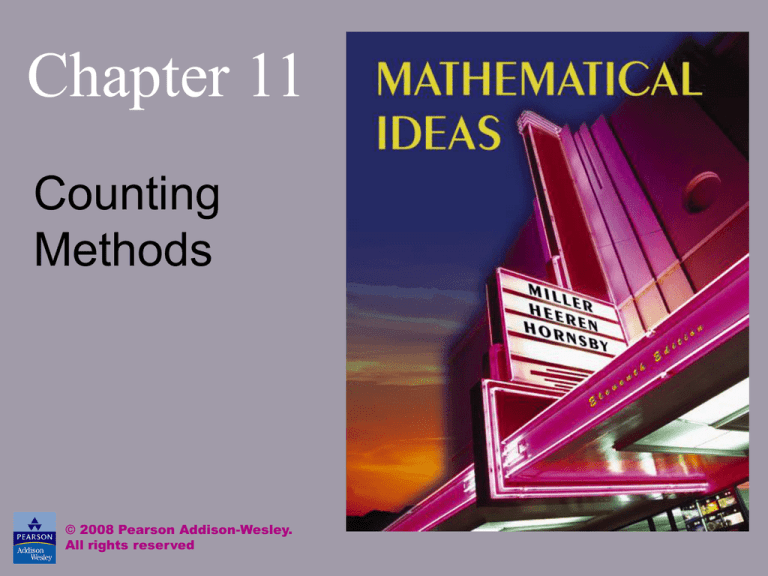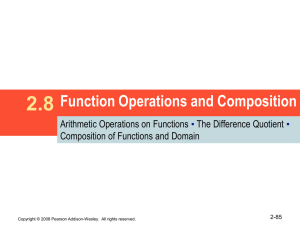
Chapter 11
Counting
Methods
© 2008 Pearson Addison-Wesley.
All rights reserved
Chapter 11: Counting Methods
11.1
11.2
11.3
11.4
11.5
Counting by Systematic Listing
Using the Fundamental Counting Principle
Using Permutations and Combinations
Using Pascal’s Triangle
Counting Problems Involving “Not” and
“Or”
11-1-2
© 2008 Pearson Addison-Wesley. All rights reserved
Chapter 1
Section 11-1
Counting by Systematic Listing
11-1-3
© 2008 Pearson Addison-Wesley. All rights reserved
Counting by Systematic Listing
•
•
•
•
One-Part Tasks
Product Tables for Two-Part Tasks
Tree Diagrams for Multiple-Part Tasks
Other Systematic Listing Methods
11-1-4
© 2008 Pearson Addison-Wesley. All rights reserved
One-Part Tasks
The results for simple, one-part tasks can
often be listed easily. For the task of tossing
a fair coin, the list is heads, tails, with two
possible results. For the task of rolling a
single fair die the list is 1, 2, 3, 4, 5, 6, with
six possibilities.
11-1-5
© 2008 Pearson Addison-Wesley. All rights reserved
Example: Selecting a Club President
Consider a club N with four members:
N = {Mike, Adam, Ted, Helen} or in abbreviated
form N = {M, A, T, H}
In how many ways can this group select a president?
Solution
The task is to select one of the four members as
president. There are four possible results: M, A, T,
and H.
11-1-6
© 2008 Pearson Addison-Wesley. All rights reserved
Example: Product Tables for Two-Part
Tasks
Determine the number of two-digit numbers that can
be written using the digits from the set {2, 4, 6}.
Solution
The task consists of two parts:
1. Choose a first digit
2. Choose a second digit
The results for a two-part task can be pictured in a
product table, as shown on the next slide.
11-1-7
© 2008 Pearson Addison-Wesley. All rights reserved
Example: Product Tables for Two-Part
Tasks
Solution (continued)
First
Digit
2
4
6
Second Digit
2
4
6
22
24
26
42
44
46
62
64
66
From the table we obtain the list of possible results:
22, 24, 26, 42, 44, 46, 62, 64, 66.
11-1-8
© 2008 Pearson Addison-Wesley. All rights reserved
Example: Possibilities for Rolling a Pair
of Distinguishable Dice
Red
Die
1
2
3
4
5
6
1
(1, 1)
(2, 1)
(3, 1)
(4, 1)
(5, 1)
(6, 1)
2
(1, 2)
(2, 2)
(3, 2)
(4, 2)
(5, 2)
(6, 2)
Green Die
3
4
(1, 3) (1, 4)
(2, 3) (2, 4)
(3, 3) (3, 4)
(4, 3) (4, 4)
(5, 3) (5, 4)
(6, 3) (6, 4)
5
(1, 5)
(2, 5)
(3, 5)
(4, 5)
(5, 5)
(6, 5)
6
(1, 6)
(2, 6)
(3, 6)
(4, 6)
(5, 6)
(6, 6)
11-1-9
© 2008 Pearson Addison-Wesley. All rights reserved
Example: Electing Club Officers
Find the number of ways club N (previous slide) can
electe a president and secretary.
Solution
The task consists of two parts:
1. Choose a president
2. Choose a secretary
The product table is pictured on the next slide.
11-1-10
© 2008 Pearson Addison-Wesley. All rights reserved
Example: Product Tables for Two-Part
Tasks
Solution (continued)
M
Pres.
M
A
T
H
AM
TM
HM
Secretary
A
T
MA MT
AT
TA
HA HT
H
MH
AH
TH
From the table we see that there are 12 possibilities.
11-1-11
© 2008 Pearson Addison-Wesley. All rights reserved
Example: Electing Club Officers
Find the number of ways club N (previous slide) can
appoint a committee of two members.
Solution
Using the table on the previous slide, this time the
order of the letters (people) in a pair makes no
difference. So there are 6 possibilities: MA, MT,
MH, AT, AH, TH.
11-1-12
© 2008 Pearson Addison-Wesley. All rights reserved
Tree Diagrams for Multiple-Part Tasks
A task that has more than two parts is not
easy to analyze with a product table. Another
helpful device is a tree diagram, as seen in
the next example.
11-1-13
© 2008 Pearson Addison-Wesley. All rights reserved
Example: Building Numbers From a Set
of Digits
Find the number of three digit numbers that can be
written using the digits from the set {2, 4, 6}
assuming repeated digits are not allowed.
Solution
First
2
4
6
Second
Third
4
6
2
6
2
4
6
4
6
2
4
2
246
264
426
462
624
642
6
possibilities
11-1-14
© 2008 Pearson Addison-Wesley. All rights reserved
Other Systematic Listing Methods
There are additional systematic ways to
produce complete listings of possible results
besides product tables and tree diagrams.
One of these ways is shown in the next
example.
11-1-15
© 2008 Pearson Addison-Wesley. All rights reserved
Example: Counting Triangles in a Figure
How many triangles (of any size) are in the figure
D
below?
Solution
E
C
One systematic
approach is to label the
F
points as shown, begin
A
B
with A, and proceed in
alphabetical order to write all 3-letter combinations
(like ABC, ABD, …), then cross out ones that are not
triangles. There are 12 different triangles.
11-1-16
© 2008 Pearson Addison-Wesley. All rights reserved







